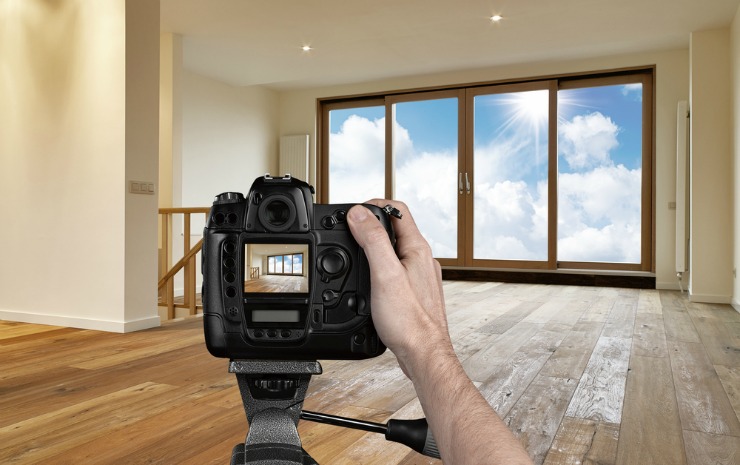You are viewing our site as an Agent, Switch Your View:
Agent | Broker Reset Filters to Default Back to ListReal Estate Photography Essentials
February 23 2016

Top agents know that professional photography can make a huge difference in the effectiveness of their real estate marketing program. High-quality photos not only attract more attention to your listings, but show that you are willing to go the extra mile to make your listings look as good as possible. This makes sellers happy, creates more buzz for your agency, and enhances the professionalism and integrity of your brand.
These days, the caliber of real estate photography ranges from low-quality cell phone pictures to professionally rendered HDR and multi-layer composite images. Developing a relationship with a good photographer or taking the time to learn how to capture and edit your own photos is essential to growing as an agent.
It’s important to know what to look for when hiring a photographer or what gear to purchase if you plan to snap the images yourself. Here are a few things to consider if you want to improve your listing photos.
Finding the right equipment
There’s a big difference in the quality of images taken with point-and-shoot (phone) cameras versus professional DSLR cameras. Professional cameras allow for wide-angle lenses and tripod attachments, and they capture images in large JPG or RAW formats that allow more flexibility when editing and cropping. Serious interior and architectural photographers will be equipped with a sturdy tripod, along with multiple lenses for their camera.
Shooting with a tripod allows you to spend more time composing your photos and take long exposures without blurriness. Properly exposed interior photos are much more pleasing to the eye than the harsh contrast of flash photography and create more depth in the image. Most professional real estate photographers would never consider using a flash on their interior photos.
For agents shooting their own photos, a wide-angle lens (at least 17 mm or less) will make a huge difference in the composition of photos and allow you to photograph narrow spaces like bathrooms with ease.
Key Term:
- Exposure – The unit of measurement for the total amount of light permitted to reach the electronic sensor during the process of taking a photograph. The two main controls your digital camera uses to control exposure are the shutter speed and aperture.
Avoiding distortion
One of the most glaring issues with many real estate photos is distortion, which makes vertical lines like doorways and columns skew out at an angle. To avoid taking distorted photos, you must ensure that your camera is perfectly aligned horizontally and vertically (using a tripod with a bubble level is a big help). Finding the right alignment may require getting lower than standing height to compose your photos on a level plane instead of just tilting the camera downward.
Key Term:
- Distortion – Perspective distortion is a warping or transformation of an object and its surrounding area that differs significantly from what the object would look like with a normal focal length, due to the relative scale of nearby and distant features.
Balancing color saturation
Another important component of great interior photos is white balance. Many amateur photographers tend to bump the saturation to create a more colorful image, but they sometimes overlook the fact that elements like bathtubs or cabinets are glowing orange instead of bright white.
The trend of oversaturated photos is quickly being replaced by properly balanced or an even desaturated look that is popular in magazines and interior decorating publications. Adjusting the ‘color temperature’ is an important part of editing that will dramatically improve the professionalism of your real estate photos.
Key Term:
- Color saturation – In graphics and imaging, color saturation is used to describe the intensity of color in the image. A saturated image has overly bright colors. Using a graphics editing program you can increase saturation on underexposed images, or vise versa.
Editing your photos
Using photo editing software will allow you to reorder, crop, and export your photos to the proper size for uploading or printing. With a little practice, anyone can properly color balance, rotate, and adjust their photos to look their best.
Listing photos should be ordered by visual appeal, typically starting with a couple of key exterior shots and then attractive interior spaces like kitchens and living rooms. There are many great online tutorials with tips for real estate photos and guides for using editing programs.
Agents hiring professional photographers will benefit from knowing about a few basic real estate photography rules. If your paid professional photos are not satisfactory, it is perfectly acceptable to ask for additional edits or a reshoot. There is a wide range of quality and professionalism among real estate photography services, so knowing how to differentiate between them will help you to make an informed decision.
High-quality photography is one of the easiest and most cost-effective ways to promote your listings, attract buyers and sellers, and stand out as an agent. Despite the fact that camera equipment is more accessible than ever, there is still a huge disparity among listing agents' photography skills. By keeping some of these basic photography principles in mind, you can ensure that you are putting out the best images possible, ultimately building your reputation as an agent and closing more deals at the end of the year.
To view the original article, visit the HomeFinder.com blog.









